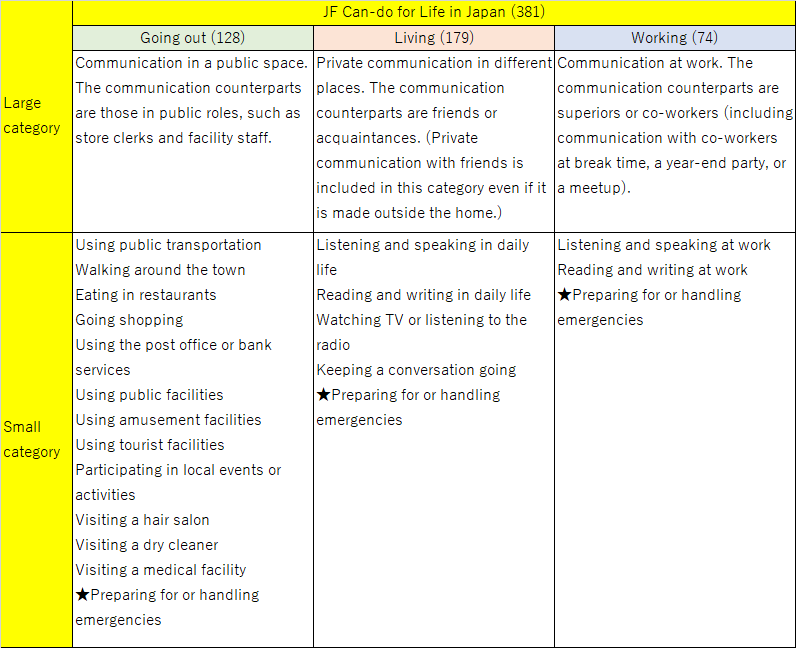JF Can-do for Life in Japan
Introduction
The Japan Foundation has developed a new series of Can-do Statements for foreign nationals who are not native speakers of Japanese. These statements, each beginning with “I can ...” and describing an ability to complete a communicative task, are called the “JF Can-do for Life in Japan” and outline the fundamental Japanese skills required for everyday life for foreign nationals living in Japan on a status of residence such as “Specified Skilled Worker.” The number of Can-dos on the list amounts to 381 items as of August 2019. *
* This list is planned to be verified continuously and has the possibility of minor modifications.
In addition, new Japanese learning resources entitled “Irodori: Japanese for Life in Japan” that set 341 Can-dos as learning goals are available online.
- Download the list of “JF Can-do for Life in Japan” from here.
- Browse or download new learning resources from here
Background and Purpose of Development
The Act for Partial Amendment of the Immigration Control and Refugee Recognition Act and the Act for Establishment of the Ministry of Justice was enacted in 2018, by which a new status of residence―“Specified Skilled Worker”―had been created. This status defines the “Specified Skilled Worker (i)” as basically required to have Japanese language proficiency to be able to engage in everyday conversation to a certain extent and handle daily life without difficulties. *
“JF Can-do for Life in Japan” illustrate basic communication mainly for daily life situations in Japan required of those who come to Japan with the above status of residence. Meanwhile, communication at work as described in it is limited to common activities considered necessary regardless of the field.
“JF Can-do for Life in Japan” can be a clue to recognizing what specific Japanese language proficiency a foreigner who will live in Japan should acquire before coming. For those who want to come to Japan with the status of residence “Specified Skilled Worker”, these Can-dos can be used to set learning objectives and to assess learning outcomes. Moreover, in Japan, it is expected that institutions and local communities that receive foreigners whose mother tongue is not Japanese would utilize them as a guide to evaluate the level of communication in the Japanese language.
Relationship between “JF Can-do for Life in Japan” and the JF Standard for Japanese-Language Education
In 2010, the Japan Foundation Japanese-Language Institute, Urawa announced the JF Standard for Japanese-Language Education (hereinafter referred to as “JFS”), which has been developed referring to the Common European Framework of Reference for Languages (CEFR). JFS is divided into six levels from A1 to C2, which correspond to those of the CEFR.
“JF Can-do for Life in Japan” were developed based on the JFS philosophy and concept.(*1) Its levels correspond to the JFS levels of A1 and A2,(*2) which consist of 158 items and 223 items, respectively. These Can-dos include items from the existing JF Can-dos used without or with partial modification. The list shows the reference numbers for the JF Can-dos used for “JF Can-do for Life in Japan”.
- *1 In developing “JF Can-do for Life in Japan”, the following is also referred to: The Standard Draft Curriculum on the Japanese Language Education for Foreigners Living in Japan by the Council for Cultural Affairs Subdivision on the Japanese Language in 2010, Report Concerning the List of Learning Items and the Development of Criteria for Step-by-Step Goal Setting in Japanese Language Education by the National Institute for Japanese Language and Linguistics in 2009, and the Japanese for Daily Life Conversation
Resources by the AJALT (https://www.ajalt.org/resource/). - *2 The level A2 is used as a guide for the aforementioned Japanese language proficiency to be able to engage in everyday conversation to a certain extent and handle daily life without difficulties.
Click here for more information on JFS.
Categories of “JF Can-do for Life in Japan”
In “JF Can-do for Life in Japan”, communication in the Japanese language in daily life and at work is divided into three large categories: going out, living, and working. Each large category is further divided into small categories that show specific communication scenes.
Fig. 1 Categories of “JF Can-do for Life in Japan”

How to Read the List of “JF Can-do for Life in Japan”
Fig. 2 List of “JF Can-do for Life in Japan” (excerpt)
| Item | Description |
|---|---|
| Number | Reference number of “JF Can-do for Life in Japan” |
| Large category | Going out, Living, and Working |
| Small category | Communication scenes picked up with “JF Can-do for Life in Japan” (See Fig. 1) |
| JFS type/reference number | Reference number of JF Can-do <Example> JF 455: The existing JF Can-do is used. (JF) 476: The existing JF Can-do is partially rewritten. JF is put into parentheses, followed by the original reference number of referred JF Can-do. |
| Level | Levels applicable to JFS |
| JF Can-do for Life in Japan | Statements described in “JF Can-do for Life in Japan” |
| Communicative language activities | Type of communicative language activities by Can-do, which are shown as listening comprehension, reading comprehension, oral production, written production, oral interaction and written interaction. |
Download of “JF Can-do for Life in Japan”
Download the list of “JF Can-do for Life in Japan” from here.
- The whole list of “JF Can-do for Life in Japan”
- The list of “JF Can-do for Life in Japan” according to large categories
- 「いろどり」で取りあげるJF生活日本語Can-doリスト【EXCEL:188KB】
(The list of “JF Can-do for Life in Japan” picked up in Irodori )


